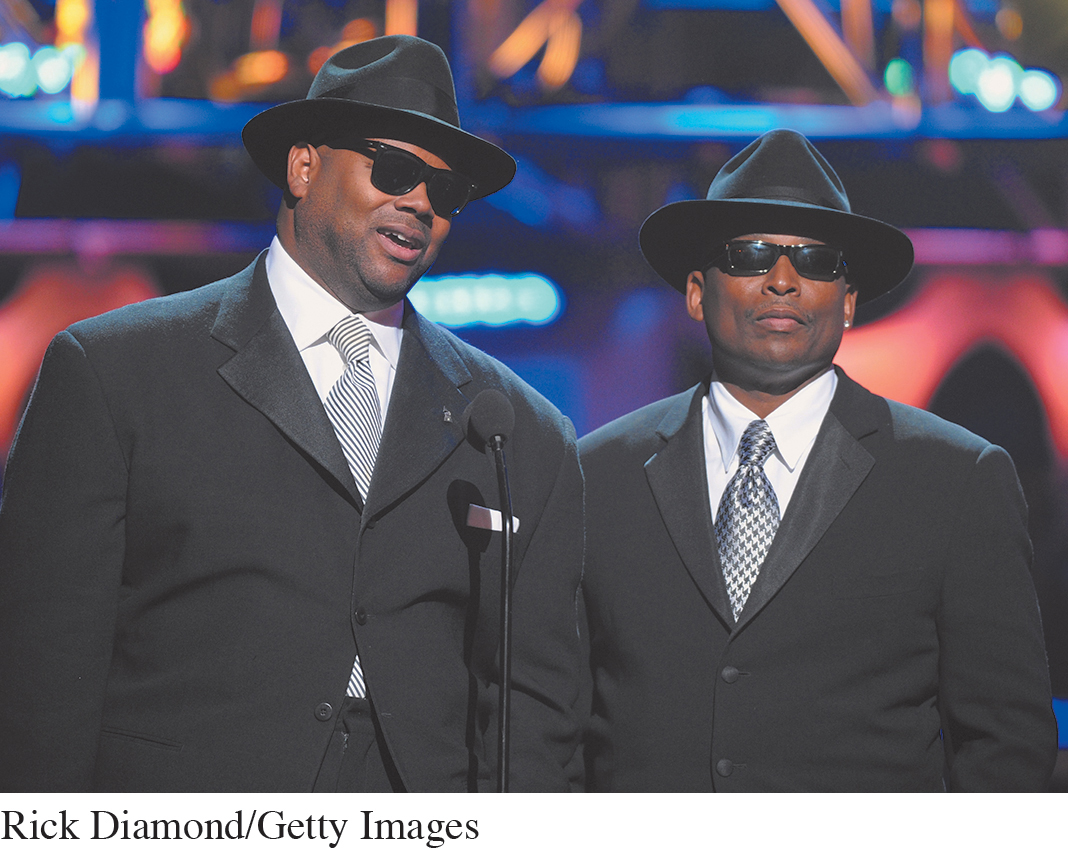Peer Relationships
What do Usher, Kanye West, and Heather Headley have in common with the Human League, Sting, and Earth, Wind, & Fire? They’ve all had songs written and produced by Terry Lewis and James “Jimmy Jam” Harris.1 The two have collaborated to produce more than 40 number-one singles, over 100 gold and platinum albums, more than a dozen movie soundtracks, and even the music for the NBA All-Star Game. But through all the fame and fortune they’ve achieved, the two still view each other primarily as musical coworkers and collaborators. “The number one thing is that we don’t do anything alone,” notes Jimmy Jam. “We approach each project as equal partners.”
Our most meaningful and intimate workplace relationships are those with our professional peers—people holding positions of organizational status and power similar to our own. Peers are the most important source of personal and practical support for employees in any type of organization, whether it’s a bank, a hospital, or a band (Rawlins, 1992). Similar to Jimmy Jam and Terry Lewis, we also develop close peer relationships in the workplace. After all, our peer relationships are not simply professional; they’re often intensely personal.
TYPES OF PEER RELATIONSHIPS
Although peer relationships strongly shape the quality of our work lives, not all peer relationships are the same (Fritz & Dillard, 1994). Information peers are equivalent-status coworkers with whom our communication is limited to work-related content. Information-peer relationships are typically created through assignment rather than choice, and as a result, they lack trust and intimacy. Although these relationships are common, especially in large corporations, many people view information peers as less open and less communicatively skilled than collegial or special peers (Myers, Knox, Pawlowski, & Ropog, 1999).

A-8
Collegial peers are coworkers whom we consider friends. When we communicate with collegial peers, we talk about work and personal issues, and we feel moderate levels of trust and intimacy toward these individuals. Scholars sometimes describe these relationships as “blended” because they incorporate elements of both professional and personal relationships (Bridge & Baxter, 1992).
Special peers are equivalent-status coworkers with whom we share very high levels of emotional support, career-related feedback, trust, self-disclosure, and friendship (Sias et al., 2002). The rarest type of peer relationship, special peers are considered best friends in the workplace.
Professional peer relationships can evolve from lesser to greater levels of intimacy over time. The first and most significant relationship transition is from information peer to collegial peer (Sias & Cahill, 1998). Workers who spend extended periods of time together, are placed in proximity with each other, or socialize together outside of the workplace inevitably form stronger bonds with each other. However, sharing time and activities together is not enough to ensure that a coworker relationship will evolve from information peer to collegial peer. Like personal friendships, perceived similarity in interests, beliefs, and values is what decisively pushes a workplace relationship from acquaintanceship to friendship (Sias & Cahill, 1998).
self-reflection
How many of your workplace peers do you consider friends rather than simply coworkers? Are there any you think of as best friends? How do your relationships with peers at work affect your feelings about your job and the organization?
The evolution of the relationship from information peer to collegial peer is similar for virtual peers—coworkers who communicate mainly through phone, e-mail, Skype, and other communication technologies. For virtual peers, the progression from information peer to collegial peer hinges on how much time the peers spend interacting and working on shared tasks together. Given the familiarity that many modern workers have with communication technologies and the availability of such technologies in the workplace, it’s commonplace for virtual peers to become virtual friends.
The transition from collegial peer to special peer is different, however. Perceived similarity, shared time and tasks, and socializing are all important, but are not sufficient to push coworker friendships to the level of best friend (Sias & Cahill, 1998). Instead, the evolution of a coworker friendship to a higher state of intimacy is usually spurred by negative events in partners’ personal lives (serious illness, marital discord) or serious work-related problems that require an exceptional level of social support.
MAINTAINING PEER RELATIONSHIPS
A-9
Like other interpersonal bonds, peer relationships remain healthy through the energy and effort you and your peers invest in maintenance. One important tactic that helps maintain your peer relationships is positivity, discussed in Chapters 10 and 11. A positive perspective and upbeat communication with your peers help offset the stress and demands everyone faces in the workplace. Practicing positivity in the workplace means communicating with your peers in a cheerful and optimistic fashion and doing unsolicited favors for them.
Openness also plays an important role. Openness means creating feelings of security and trust between you and your peers. You can create such feelings by behaving in predictable, trustworthy, and ethical ways in your relationships with peers. This means following through on your promises, respecting confidences, and demonstrating honesty and integrity in both your personal and your professional behavior.
Two additional tactics will help you maintain your collegial- and special-peer relationships (Sias et al., 2002). Like assurances given to a romantic partner, assurances given to collegial and special peers help demonstrate your commitment to them. Since choice is what distinguishes close peer relationships from casual ones, a critical part of maintaining these relationships is routinely stressing to your collegial and special peers that your relationships are based on choice rather than professional assignment. This can be accomplished indirectly by inviting peers to join you in activities outside the workplace, which implies that you consider them friends and not just coworkers. More directly, you can straightforwardly tell collegial and special peers that you think of them primarily as friends.
A-10
Second, collegial- and special-peer relationships grow stronger when the people involved treat each other as whole human beings with unique qualities and do not strictly define each other as just coworkers. Certainly, you will discuss work, but since your relationships with collegial and special peers are blended, you will also discuss your personal lives.
